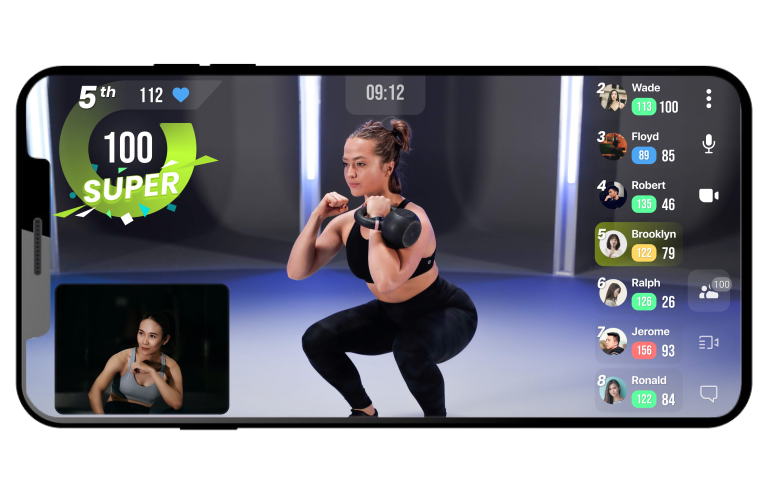Traditionally, CES has not was the healthiest week for me. Aside from some unintended intermittent fasts, TechCrunch really has a habit of spicing it up with our team dinners at the show, not to mention Matt’s almost religious devotion to a Mexican place called Tacos & Beer.
In my defense, I want to say that there hasn’t been a year that I haven’t blown my step count multiple times each day of the show. Strolling through the hall of the Las Vegas Convention Center does it to a tech journalist. This year, of course, my steps have suffered as TechCrunch decided to virtually attend the show amid omicron-related concerns.
To be honest, I was wondering if I should go back to the gym too. I’m certainly not alone in that either. While it’s true that companies like Peloton have seen a rebound while gyms and the like reopened late last year, this pandemic is far from over. And the idea of being in a narrow space with loads of other breathtaking people doesn’t seem ideal, even if it is currently too cold in many parts of the country to exercise a lot outside.
It’s always difficult to predict the longevity of these types of trends, but it’s pretty safe to say that the past few years have shown a profound change in the world of home fitness. I’ve personally spoken to a lot of people who don’t plan on going back to the gym after all of this (well, assuming all of this is ever really over, I guess). This is not just a symptom of the pandemic, of course – companies like Peloton and Mirror gained a lot of traction before many of us knew what a novel coronavirus was.
Of course, when it rains, this stuff pours it. My inbox has been bombarded with home fitness services for the past several years. It is clear that as many companies as possible are trying to capitalize on this moment, and how can they get it into debt between Peloton’s revenue and transactions like Lululemon’s acquisition of Mirror? We’ve certainly seen an upward trend at last year’s all-virtual CES, but they’re inevitable in 2022.
As in any ultra-hot technology category, few will survive. Peloton should have made a huge impact on the event in several ways, including a keynote address from CEO John Foley – though the fitness brand earlier this week joined a long list of companies that have declined to attend. Despite these concerns, however, there were many products that were more than ready to fill this void.
Credit: LG
LG’s offering in this category was far more conceptual than practical. If anything, the company’s stationary bike was designed to show how its curved monitor technology can be integrated with home fitness. Given the size of the product, it seemed like a pretty solid indictment on yourself as space and price are very important for many who want to add exercise equipment to their home.
To be honest, I am surprised that there have been no more attempts to invade the term “metaverse” in this year’s home fitness pitches. There the VR fitness app Liteboxer wins the award. “The beginning of the metaverse indicates the demand for a deeper sense of connectivity,” said Co-Founder and CEO Jeff Morin in a press release. “Virtual reality workouts connect people in a way that is more meaningful than a 2D screen on a tablet, phone, or computer. With just one VR headset and your will to win, anyone can now train anywhere in the world with the best trainers, routes and fitness technology. “
The word “meta” is mentioned four times in the above publication. In this case, it seems pretty interchangeable with the term “VR” as that’s a title for the Quest 2 headset. Liteboxer VR arrives at the Quest Store on March 3rd and costs $ 19 per month for a subscription.
Echelon unveiled its EX-8s Connect Bike, designed to take on Peloton’s high-end Bike + and only marginally undercut the product at $ 2,399. That’s a high price to pay for a company that also makes highly affordable products for Walmart. At that price, you get a curved 24-inch 1080p display and a customizable light show for the wheels, among other things. It should arrive this month.
Credit: WonderciseWondercise, on the other hand, is a software-first solution. The company aims to offer a platform designed to connect remote exercise fans and break some of the isolation that comes with moving from the gym to home. According to the company’s press material:
The live leaderboard displays scores based on a person’s technique and creates a fun atmosphere in the sessions. Colorful power bars and profiles on the screen have been purposely designed to make the experience feel like a game and add a competitive dimension to training. Wondercise is focused on bringing the Internet of Things to the fitness industry so everyone can get the performance analysis and data they need, wherever they are exercising.
However, as crowded as the home device category becomes, it is nothing compared to software-first solutions, and Wondercise will compete directly with big names like Apple and Samsung.
Hydrow, meanwhile, was one of the most important companies representing home rowers. It’s a category beyond the saturated world of treadmills and bikes that is best suited for real growth. Rowers provide more physical exercise than bikes, but generally burn fewer calories. It is rumored that Peloton is getting into the rowing machine game, but for now, Hydrow is emerging as the big name in the industry.


